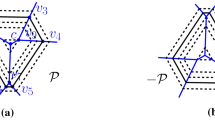Abstract
A Euclidean skeleton is a set of edges in the interior (or on the boundary) of a polygon that intersects any line segment that joins two points outside of the polygon and that intersects the polygon. In this paper we study minimum cardinality Euclidean skeletons and develop an algorithm for constructing them. We first prove a number of structural properties of minimum skeletons and use these to develop a canonical form. We then design an exact algorithm which initially generates a set of canonical skeleton edges, then executes a pruning module to reduce the set of candidate edges, and finally runs existing integer linear programming code to output an optimal solution. Finally, we perform computational testing on our algorithm to demonstrate its performance, and observe a number of experimental properties of minimum skeletons.



















Similar content being viewed by others
References
Masehian, E., Amin-Naseri, M.: A Voronoi diagram-visibility graph-potential field compound algorithm for robot path planning. J. Robot. Syst. 21(6), 275–300 (2004)
Ganley, J.L., Cohoon, J.P.: Routing a multi-terminal critical net: Steiner tree construction in the presence of obstacles. In: Proceedings of IEEE International Symposium on Circuits and Systems-ISCAS’94, vol. 1, pp. 113–116. IEEE (1994)
Liu, C.H., Kuo, S.Y., Lee, D., Lin, C.S., Weng, J.H., Yuan, S.Y.: Obstacle-avoiding rectilinear Steiner tree construction: a Steiner-point-based algorithm. IEEE Trans. Comput. Aided Des. Integr. Circuits Syst. 31(7), 1050–1060 (2012)
Huang, T., Young, E.F.: ObSteiner: an exact algorithm for the construction of rectilinear Steiner minimum trees in the presence of complex rectilinear obstacles. IEEE Trans. Comput. Aided Des. Integr. Circuits Syst. 32(6), 882–893 (2013)
Müller-Hannemann, M., Tazari, S.: A near linear time approximation scheme for Steiner tree among obstacles in the plane. Comput. Geom. 43(4), 395–409 (2010)
Huang, T., Young, E.F.: Obstacle-avoiding rectilinear Steiner minimum tree construction: an optimal approach. In: Proceedings of the International Conference on Computer-Aided Design, pp. 610–613. IEEE Press (2010)
Provan, J.S.: An approximation scheme for finding Steiner trees with obstacles. SIAM J. Comput. 17(5), 920–934 (1988)
Zachariasen, M., Winter, P.: Obstacle-Avoiding Euclidean Steiner trees in the Plane: An Exact Algorithm, pp. 286–299. Springer, Berlin (1999)
Volz, M., Brazil, M., Ras, C., Thomas, D.: Computing skeletons for rectilinearly-convex obstacles in the rectilinear plane. arXiv:2004.04365 (2020)
Provan, J.S., Brazil, M., Thomas, D., Weng, J.F.: Minimum opaque covers for polygonal regions. arXiv:1210.8139 (2012)
Hakimi, S.L.: Steiner’s problem in graphs and its implications. Networks 1, 113–133 (1971)
Zhu, C., Sundaram, G., Snoeyink, J., Mitchell, J.S.: Generating random polygons with given vertices. Comput. Geom. 6(5), 277–290 (1996)
Lafayette, L., Sauter, G., Vu, L., Meade, B.: Spartan performance and flexibility: an HPC-cloud chimera. OpenStack Summit, Barcelona 27 (2016)
Fischetti, M., Leitner, M., Ljubić, I., Luipersbeck, M., Monaci, M., Resch, M., Salvagnin, D., Sinnl, M.: Thinning out Steiner trees: a node-based model for uniform edge costs. Math. Program. Comput. 9(2), 203–229 (2017)
Cplex, I.I.: V12.1: User’s manual for CPLEX. Int. Bus. Mach. Corp. 46(53), 157 (2009)
Author information
Authors and Affiliations
Corresponding author
Additional information
Publisher's Note
Springer Nature remains neutral with regard to jurisdictional claims in published maps and institutional affiliations.
Rights and permissions
About this article
Cite this article
Andrés-Thió, N., Brazil, M., Ras, C. et al. An exact algorithm for constructing minimum Euclidean skeletons of polygons. J Glob Optim 83, 137–162 (2022). https://doi.org/10.1007/s10898-021-01101-3
Received:
Accepted:
Published:
Issue Date:
DOI: https://doi.org/10.1007/s10898-021-01101-3




